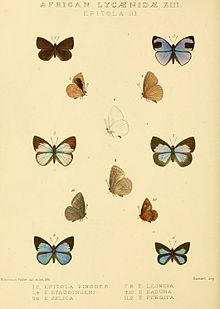플랜타기누스과
Plantaginaceae| 플랜타기누스과 | |
|---|---|
 | |
| 스코파리아둘시스 | |
| 과학적 분류 | |
| 왕국: | 플랜태 |
| Clade: | 기관지 식물 |
| Clade: | 혈관배양액 |
| Clade: | 유디코트 |
| Clade: | 별자리 |
| 주문: | 라미알레스 |
| 패밀리: | 플랜타기누스과 쥐스.[1] |
| 표준속 | |
| 플랜타고 | |
| 부족 | |
| 동의어[2] | |
| |
플랜테인과(요리 플랜테인과는 관련이 없음)는 라미알레스목의 꽃이 피는 식물의 과이다.오래된 분류에서는 식물목의 유일한 과였지만, Angiosperm Phylogeny Group에 의해 요약된 수많은 계통발생학 연구에서 이 분류군이 Lamiales에 포함되어야 한다는 것이 입증되었다.
개요
전통적으로 제한된 식물군은 부게리아, 리토렐라, 플랜타고 등 3개 속만으로 구성됐다.그러나 계통학 연구는 Plantaginaceae sensu stricto(엄격한 의미에서)가 Scropulariaceae(그러나 Scropularia)의 표준속인 Scropularia를 포함하지 않는 군을 형성하고 있음을 보여주었다.Veronicaceae(1782)가 이 과의 가장 오래된 성씨이지만 Plantaginaceae(1789)는 국제식물명칭법(ICBN)에 따라 보존된 이름이므로 Plantago를 포함한 과의 초기 성씨보다 우선한다.게다가 ICBN은 1789년 이전에 출판된 성씨를 보존 대상으로 간주하지 않아 베로니카과는 배제하고 있다.Antirrhinaceae라는 이름은 Plantaginaceae의 보존을 위해 제안되었다.한편 Angiosperm Phylogeny 그룹은 Plantaginaceae라는 이름을 받아들였다.그러나 옴스테드(2003)[3]는 나중에 동의어인 베로니카과(Veronicaceae)라는 이름을 사용하기로 결정했다.
린데니아를 포함한 한 무리의 속은 현재 린데니아과로 [6]분리되었으며[4][5], Haston et al. 2007(LAPG II라고도 함)에 의해 "Post-APG II 과"로 인식되었다.
Plantaginaceae sensu lato(넓은 의미)는 다양하고 세계적인 과로, 주로 온대 지역에서 발견된다.이 그룹은 허브, 관목 그리고 뿌리가 있는 몇몇 수생 식물(예: Calitriche속과 같은.집안이 워낙 다양하기 때문에 [4]그 범위를 정하기가 어렵다.
그 잎들은 나선형으로 반대쪽을 향하고 복합적이기 쉽다.라미알레스에서 특이한 점은 선모 머리에 수직 칸막이가 없다는 것이다.
꽃의 구조와 형태는 다양합니다.아라고아처럼 (4개의 꽃잎과 4개의 꽃잎을 가진) 4개의 성체가 있고, 시보르피아처럼 5개에서 8개의 성체가 있다.대부분의 속 꽃은 다대칭이다.화관은 종종 입술이 두 개 있다.몇몇 분류군에서는 안드로슘이 화관 앞에 형성된다.
그 과일은 세포 [7]사이의 칸막이를 통해 분해되는 캡슐이다.
속
확대된 Plantaginaceae는 94개 속과 약 1,900여 [8]종으로 구성되어 있습니다.가장 큰 속은 베로니카로 약 450여 종을 가지고 있다.베로니카에는 헤베속, 파라헤베속, 신티리스속도 포함되어 있으며, 이전에는 종종 구별되는 것으로 취급되었다.플랜타기니과의 모든 속은 특별한 언급이 없는 한 이전에는 Scropulariaceae에 포함되었습니다.
|
GRIN은 Antirhineae [10]부족에 Lafuentea Lag.를 포함하지만, Albach(2005)[4]가 지적한 바와 같이 Ferndez-Mazuecos 등의 계통발생학적 분석(2013)[22]에서 Antirhineae의 자매였다.당분간 그것은 아웃그룹으로 간주되어야 한다.
제외속
레퍼런스
- ^ Angiosperm Phylogeny Group (2009). "An update of the Angiosperm Phylogeny Group classification for the orders and families of flowering plants: APG III" (PDF). Botanical Journal of the Linnean Society. 161 (2): 105–121. doi:10.1111/j.1095-8339.2009.00996.x. Retrieved 2013-07-06.
- ^ "Family: Plantaginaceae Juss., nom. cons". Germplasm Resources Information Network. 2003-01-17. Archived from the original on 2011-07-04. Retrieved 2011-04-28.
- ^ Olmstead, Richard G. (2002). "Whatever happened to the Scrophulariaceae?" (PDF). Fremontia. 30: 13–22.
- ^ a b c Albach, D. C.; Meudt, H. M.; Oxelman, B. (2005). "Piecing together the "new" Plantaginaceae". American Journal of Botany. 92 (2): 297–315. doi:10.3732/ajb.92.2.297. PMID 21652407.
- ^ Oxelman, B.; Kornhall, P.; Olmstead, R. G.; Bremer, B. (2005). "Further disintegration of Scrophulariaceae". Taxon. 54 (2): 411–425. doi:10.2307/25065369. JSTOR 25065369.
- ^ Rahmanzadeh, R.; Müller, K.; Fischer, E.; Bartels, D.; Borsch, T. (2005). "The Linderniaceae and Gratiolaceae are further lineages distinct from the Scrophulariaceae (Lamiales)". Plant Biology. 7 (1): 67–78. doi:10.1055/s-2004-830444. PMID 15666207.
- ^ Haston, E., Richardson, J. E., Stevens, P. F., Chase, M. W., Harris, D. J. (2007). "A linear sequence of Angiosperm Phylogeny Group II families". Taxon. 56 (1): 7–12. doi:10.2307/25065731. JSTOR 25065731.
- ^ Christenhusz, M. J. M.; Byng, J. W. (2016). "The number of known plants species in the world and its annual increase". Phytotaxa. 261 (3): 201–217. doi:10.11646/phytotaxa.261.3.1.
- ^ "GRIN Genera of Plantaginaceae tribe Angelonieae". Germplasm Resources Information Network. Archived from the original on 2015-09-24. Retrieved 2011-04-28.
- ^ a b "GRIN Genera of Plantaginaceae tribe Antirrhineae". Germplasm Resources Information Network. Retrieved 2011-04-28.
- ^ "GRIN Genera of Plantaginaceae tribe Callitricheae". Germplasm Resources Information Network. Archived from the original on 2015-09-24. Retrieved 2011-04-28.
- ^ Crosswhite, Frank S.; Kawano, Shoichi (1970). "Pennellianthus (Scrophulariaceae)--A New Genus of Japan and USSR". The American Midland Naturalist. pp. 358–367. doi:10.2307/2423949. Retrieved 11 November 2021.
- ^ "GRIN Genera of Plantaginaceae tribe Cheloneae". Germplasm Resources Information Network. Archived from the original on 2015-09-24. Retrieved 2011-04-28.
- ^ "GRIN Genera of Plantaginaceae tribe Digitalideae". Germplasm Resources Information Network. Archived from the original on 2015-09-24. Retrieved 2011-04-28.
- ^ "GRIN Genera of Plantaginaceae tribe Globularieae". Germplasm Resources Information Network. Archived from the original on 2015-09-24. Retrieved 2011-04-28.
- ^ "GRIN Genera of Plantaginaceae tribe Gratioleae". Germplasm Resources Information Network. Archived from the original on 2015-09-24. Retrieved 2011-04-28.
- ^ "GRIN Genera of Plantaginaceae tribe Hemiphragmeae". Germplasm Resources Information Network. Archived from the original on 2015-09-24. Retrieved 2011-04-28.
- ^ "GRIN Genera of Plantaginaceae tribe Plantagineae". Germplasm Resources Information Network. Archived from the original on 2015-09-24. Retrieved 2011-04-28.
- ^ "GRIN Genera of Plantaginaceae tribe Russelieae". Germplasm Resources Information Network. Archived from the original on 2015-09-24. Retrieved 2011-04-28.
- ^ "GRIN Genera of Plantaginaceae tribe Sipthorpieae". Germplasm Resources Information Network. Archived from the original on 2015-09-24. Retrieved 2011-04-28.
- ^ "GRIN Genera of Plantaginaceae tribe Veroniceae". Germplasm Resources Information Network. Archived from the original on 2015-09-24. Retrieved 2011-04-28.
- ^ Fernández-Mazuecos, Mario; Blanco-Pastor, José Luis; Vargas, Pablo (February 2013). "A Phylogeny of Toadflaxes (Linaria Mill.) Based on Nuclear Internal Transcribed Spacer Sequences: Systematic and Evolutionary Consequences". International Journal of Plant Sciences. 174 (2): 234–249. doi:10.1086/668790. JSTOR 10.1086/668790. S2CID 85302392.
- ^ "GRIN genera sometimes placed in Plantaginaceae". Germplasm Resources Information Network. Archived from the original on 2004-11-18. Retrieved 2011-04-28.
- Olmstead, R. G., dePamphilis, C. W., Wolfe, A. D., Young, N. D., Elisons, W. J. & Reeves P. A. (2001). "Disintegration of the Scrophulariaceae". American Journal of Botany. 88 (2): 348–361. doi:10.2307/2657024. JSTOR 2657024. PMID 11222255.
{{cite journal}}: CS1 maint: 여러 이름: 작성자 목록(링크)
참고 문헌
외부 링크
 Wikimedia Commons의 Plantaginace와 관련된 매체
Wikimedia Commons의 Plantaginace와 관련된 매체 Wikis 종 Plantaginaceae 관련 자료
Wikis 종 Plantaginaceae 관련 자료- MOBOT의 식물성 처리




